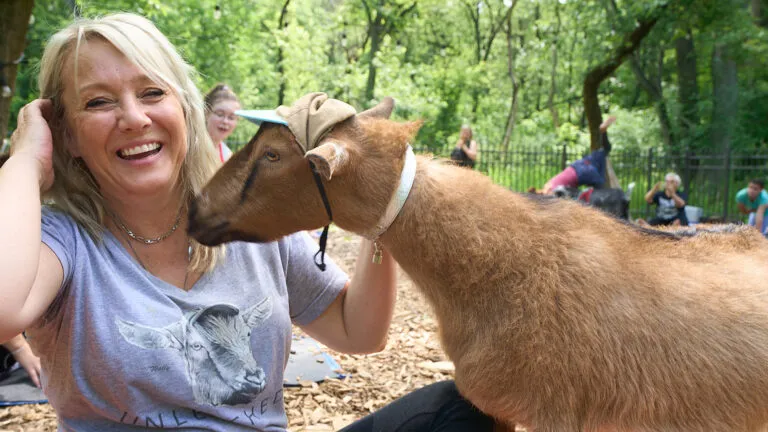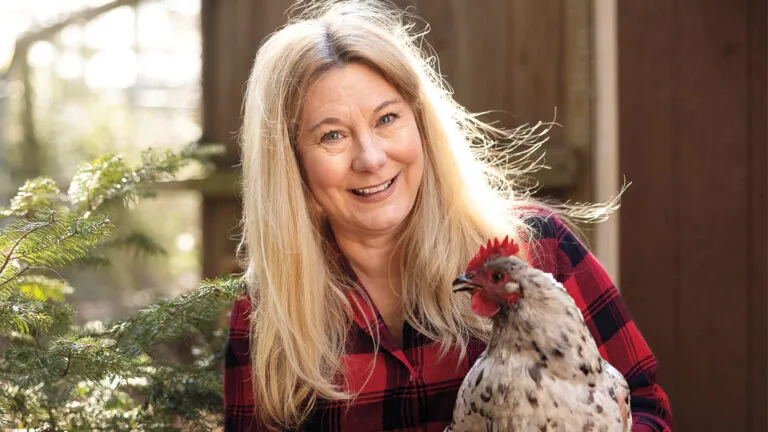One morning when she was 19, Carol Buckley heard her dog barking frenziedly. She looked out the window of her Southern California home and couldn’t believe her eyes. A man was taking a baby elephant for a walk. “I ran outside and introduced myself,” Carol says. “The man had just bought the elephant as a mascot for his tire dealership. ‘Come and see her anytime,’ he told me. By the time they’d finished their walk, I was at the store waiting for them.”
Carol was always bringing home injured rabbits and birds, so naturally she showed up every day to take care of the little elephant. She taught her some simple tricks, like curtsying and playing the xylophone with her trunk.
“I fell in love,” Carol remembers. “She was so smart, so responsive. Being with her was almost like being with a close friend.”
Elephants form extraordinarily deep, lifelong relationships. In the wild, they protect their wounded or sick, nurture their young, and grieve when one of their own dies. A tire dealership was hardly an appropriate place for such a sensitive creature, Carol decided.
Her dad helped her get a loan to buy the elephant. But it was up to her to find a way to support herself and an animal—now christened Tarra—with one of the largest brains on the planet and a diet of more than 150 pounds of food a day. Carol had taught Tarra a complete routine of tricks. She was out of school and looking for a path in life. So Carol and Tarra took their act on the road, working in circuses around the country.
“It was a huge adventure,” recalls Carol. “Tarra loved performing. She couldn’t wait to get into the spotlight. Definitely she was born to be a star.”
Carol varied Tarra’s routines to keep them challenging, and during off hours she’d find an empty field or riverbank where they could play. Something troubled her though. Most owners and trainers weren’t nearly so considerate of their animals. Cramped trailers and cages, the same old routines, even cruelty. Being a captive elephant was no fun.
And not just for other elephants. Carol noticed that Tarra wasn’t enjoying performing the way she once did. So Carol came up with a radical stunt. “People imagine elephants’ legs being big, clumsy columns,” she says. “Not true. Tarra has incredibly flexible feet and toes. I decided she would become the world’s first roller-skating elephant.”
She enlisted the help of a welder and a bootmaker—who refused until Carol had him meet Tarra. Tarra took to skating like she’d been born on wheels. Circuses and promoters ate it up.
Carol liked to hold question and answer sessions with the public, especially children. One day when Tarra was seven years old, a woman stood up and said, “How can you feel good about what you’re making this animal do?”
Carol was taken aback. I love Tarra, she thought. I’d do anything in the world for her. All the same, the woman’s words wouldn’t leave her alone.
One day while Carol was watching some children feed Tarra apples and oranges, the father of one of the kids extended an orange. Tarra reached for it with her trunk. The man pulled it back. Tarra reached again. Again the man teased her, pulling the orange away. “He was using her to show off, I guess,” says Carol.
Something in Tarra just snapped. Gently but firmly, she pushed the man over with her trunk. Take that! Remember, Tarra needs 150 pounds of food a day.
Carol was shocked, even alarmed. Tarra had never done anything like that. Then that woman’s words came back to her. Looking at Tarra, Carol suddenly saw something she’d never seen before: a wild creature whose deepest needs were going unmet. If I really love you, Tarra, I have to do what’s best for you.
But how? By sending Tarra, now deeply bonded to Carol, back to the wilds of Asia? Not an option. Still, as a first step, Carol got Tarra out of circus work. The two embarked on an odyssey from zoo to zoo, wildlife park to wildlife park, trying to find an environment where Tarra could live a life that was closer to what it would have been in the wild. But there were always problems: not enough space in one facility, demands for Tarra to perform or give rides in another. A zoo or wildlife park might be a better place for an elephant than a circus, but it was still miles from what Tarra really needed.
Then one morning, Carol woke up with an incredible image in her mind. She couldn’t really explain it. More than an image. A vision. A place of fields and forests and rivers, where retired zoo and circus elephants could live as the magnificent wild creatures they are, completely free from human interference and demands.
Such a place didn’t exist yet—no one was more aware of that than Carol. But she suddenly understood that it had to, and that it was her mission in life to bring it into existence.
“The Elephant Sanctuary spent ten years as an idea before it finally came to fruition,” says Carol. “I looked all over the country, trying to find a landscape and climate that would mimic what an Asian elephant would experience. I got a partner, and ultimately we zeroed in on Tennessee. A realtor took me to this property here in Hohenwald. It was the exact picture that had been put in my head. I felt I’d been led to it. Everything was right.”
In 1995, the nonprofit Elephant Sanctuary opened with Tarra as its founding member. Half a dozen Asian elephants retired from zoos and circuses are now enjoying a new lease on life on nine hundred unspoiled acres of Tennessee countryside. Support comes from a variety of places, including corporations, foundations, and ordinary people who want to do something kind for elephants.
Perhaps most notable of all, the sanctuary is closed to the general public. Cameras set up around the sanctuary allow for videoconferencing and online visits, but there are no noisy crowds to bother the residents. These are retirees, after all.
“Elephants live up to seventy years,” says Carol. “Some of our elephants have spent decades in unpleasant environments. It can take them a while to recover and realize they’re in a safe place, but when it happens it’s wonderful. You can tell by that spark in their eyes. They know they’re home.”
Just ask Tarra.
For more inspiring stories, subscribe to Guideposts magazine.





